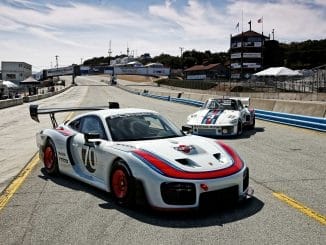 The unveiling of the first Porsche 911 GT3 in March 1999 at the Geneva Motor Show signalled the start of a new era for discerning sports car drivers. Like no other Porsche 911, the GT3 embodies the hallmarks of Porsche Motorsport.
The unveiling of the first Porsche 911 GT3 in March 1999 at the Geneva Motor Show signalled the start of a new era for discerning sports car drivers. Like no other Porsche 911, the GT3 embodies the hallmarks of Porsche Motorsport.
Developed by two-time World Rally Champion Walter Röhrl, race engineer Roland Kussmaul and the Porsche Motorsport specialists from Weissach, the Porsche 911 GT3 brought race track agility to the road. Since then, this road-going athlete has become even faster, more precise and more dynamic with every generation — and with a naturally aspirated engine, manual transmission and rear-wheel drive, it remains the most popular Porsche 911 among purists up to the present day.
The race versions of the Porsche 911 GT3 have written motorsport history. In addition to countless class wins, the GT3 achieved numerous overall victories in the major endurance races, including the 24 Hours of Spa, the 24 Hours of Daytona and the 24 Hours Nürburgring, which it won seven times starting with the year 2000. It is part of the recipe for success of the Porsche 911 GT3 that the experience and innovations from motorsport are always incorporated into the development of the next road version. It is no wonder that around 80 per cent of all 911 GT3 ever produced are regularly driven on the race track.
Successor to the 911 Carrera RS 2.7: the first GT3 made its debut in 1999
Shortly before the start of the new century and featuring advanced racing technology, the Porsche 911 GT3 continued the tradition that had started in the 1970s with the legendary Porsche 911 Carrera RS 2.7. For the first time, the model was not given the designation “RS” for Race Sport, but the name GT3 — a reference to the GT class in which the motorsport versions of the model were to compete. The water-cooled 3.6-litre six-cylinder boxer engine of the new sports car delivered 265 kW (360 PS). Therefore it was hardly a surprise that the Porsche 911 GT3 had already earned its first laurels even before its debut in Geneva: with Walter Röhrl at the wheel, it completed the 20.8 kilometre Nürburgring Nordschleife in less than eight minutes — and in so doing set a new benchmark for road-going sports cars.
Such exceptional performance was made possible not just by the race-proven boxer engine, but also thanks to a precisely tuned overall package: the chassis was lowered by around 30 millimetres and the brakes uprated. The six-speed manual transmission originated from the Porsche 911 GT2. The gearbox ratios, axle geometry, anti-roll bars and springs could be adapted depending on the circuit conditions. Lightweight construction came before comfort. A distinctive sign of its motorsport origins was the fixed rear wing of the 911 GT3. As an option, customers were able to order their 911 GT3 as a Clubsport variant, which also included a bolt-in roll cage.
The first Porsche 911 GT3 vehicles rolled off the production line in Weissach in May 1999. As a homologation basis for motorsport, the new model also provided the foundation for the successful 911 GT3 Cup and the higher-positioned race versions — the 911 GT3 R and GT3 RSR, which achieved brilliant results in one-make and GT racing in the coming years.
New generations in quick succession
After the great success of the first 911 GT3, Porsche presented a new evolution stage of the road-going sports car with racing genes every three to four years. In 2003, the power of the boxer engine increased to 280 kW (381 PS) thanks to the use of the VarioCam continuously variable camshaft control system. The GT3 could also now be ordered with the ultra-high-performance Porsche Ceramic Composite Brake (PCCB) system. The next increase in power, to 305 kW (415 PS), followed three years later. For the first time, the Porsche 911 GT3 featured an active suspension with the sporty Porsche Active Suspension Management (PASM). In 2009, the engineers increased the displacement of the six-cylinder boxer engine to 3.8-litres and the power to 320 kW (435 PS). The all new rear wing and full underbody panelling produced such a substantial increase in downforce that this was more than doubled in comparison to its predecessor.
On the 50th birthday of the Porsche 911 in 2013, the fifth generation of the 911 GT3 celebrated its world premiere at the Geneva Motor Show. The engine, transmission, body and chassis were completely new. The drivetrain consisted of a 3.8-litre naturally aspirated engine with 350 kW (475 PS), mated for the first time to a Porsche Doppelkupplung (PDK) dual-clutch transmission. Also for the first time, this was complemented by active rear axle steering. By way of introduction, the new 911 GT3 completed the Nürburgring Nordschleife in just 7:25 minutes —more than half a minute faster than the first 911 GT3 on its record lap in 1999.
The latest version of the 911 GT3 was launched in 2017. The focus of development had been on the six-cylinder boxer engine: its displacement increased to 4.0 litres and the power output was 368 kW (500 PS). Porsche also had two treats for purists: on the one hand, a manual six-speed transmission was now available as an alternative to the PDK. On the other, the 911 GT3 could be ordered with a discreet Touring Package, in which the fixed rear wing was replaced by an automatically extending spoiler — pure understatement. And so things come full circle: the designation “Touring Package” was a reference to the more restrained version of the legendary Porsche 911 Carrera RS 2.7 from the 1970s.







